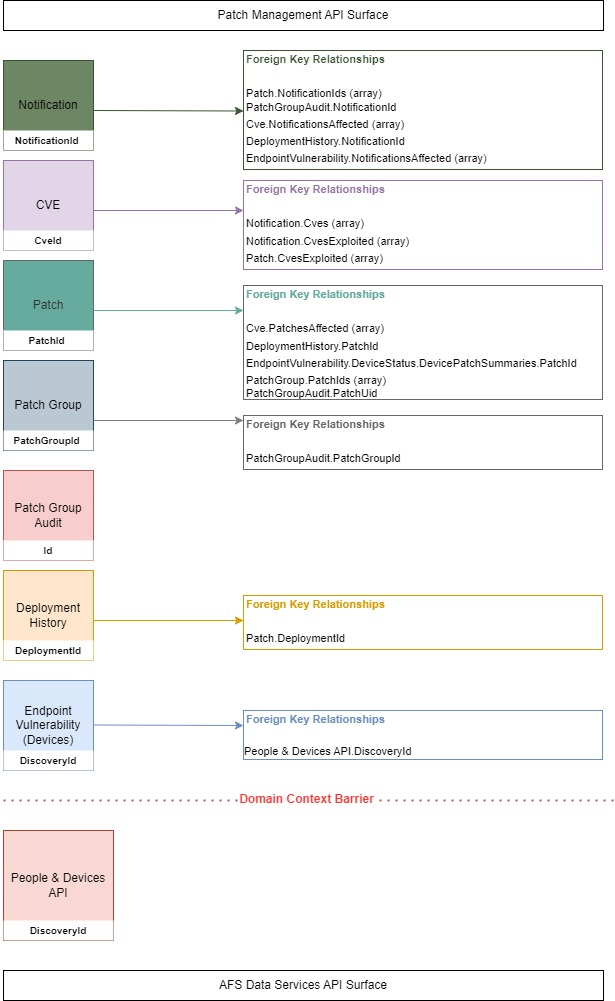Patch Management API
This guide describes the basic information you need to get up and running with the Ivanti Neurons for Patch Management API. It is assumed that you have some prior experience using a REST API.
The Ivanti Neurons for Patch Management API provides access to the Patch Management feature in Ivanti Neurons. The API is used to support the use of third-party reporting tools.
Available Endpoints
The following are the endpoints with which you can interact.
- authentication: Enables you to retrieve the JWT access token.
- cve: Enables you to retrieve the set of data items that represents a CVE and its related metadata.
- cves-to-patch-group: Enables you to specify CVE IDs that you want to convert to a patch group.
- deployment-history: Enables you to retrieve the set of data items that represents a deployment history result.
- endpoint-vulnerability: Enables you to retrieve the set of data items that represents an Endpoint Vulnerability device overview.
- notification: Enables you to retrieve the set of data items that represents a notification result, such as a security bulletin.
- patch: Enables you to retrieve the set of data items that represents a patch and its related metadata.
- patch-group: Enables you to retrieve the set of data items that represents a patch group and its related metadata.
- patch-group-audit: Enables you to retrieve the set of data items that represents all changes that have occurred to a given patch group.
Rate Limit and Requests
Neurons for Patch Management supports a rate limit of 150 requests per minute. The number of requests are limited to 172,800 per day.
Relationships
The return code from certain calls can contain data that is related to other areas in the API. The following data fields have relationships with other endpoints.
|
Endpoint |
Related Output Data Item |
|---|---|
|
cveId is the primary key in this collection |
notificationsAffected: The notification endpoint can be used to query for additional details related to the notification ID. patchesAffected: The patch endpoint can be used to query for additional details related to specific patches. |
|
deploymentId is the primary key in this collection |
discoveryId: The People and Devices API can be used to query for additional details about the users and devices. notificationId: The notification endpoint can be used to query for additional details related to the notification ID. patchId: The patch endpoint can be used to query for additional details related to the patch ID. |
|
discoveryId is the primary key in this collection |
discoveryId: The People and Devices API can be used to query for additional details about the users and devices. notificationsAffected: The notification endpoint can be used to query for additional details related to the notification ID. patchesAffected: The patch endpoint can be used to query for additional details related to specific patches. deviceStatus.devicePatchSummaries.patchId: The Patch endpoint can be used to query for additional details. deviceStatus.devicePatchSummaries.notificationId: The notification endpoint can be used to query for additional details. |
|
notificationId is the primary key in this collection |
cves: The cve endpoint can be used to query for the list of CVEs addressed in the notification. cvesExploited: The cve endpoint can be used to query for collection of exploited CVEs. |
|
patchId is the primary key in this collection |
cveExploited: The cve endpoint can be used to query for additional details about the CVEs. deploymentId: The deployment-history endpoint can be used to query for additional details related to the deployment ID. notificationIds: The notification endpoint can be used to query for additional details related to the notification IDs. |
|
patchGroupId is the primary key in this collection |
patchIds: The patch endpoint can be used to query for additional details related to specific patches. |
|
This collection uses a composite natural key, each row is a unique document |
patchGroupId: The patch-group endpoint can be used to query for additional details related to the parent patch group. patchUid: The patch endpoint can be used to query for additional details related to the specific patch. notificationId: The notification endpoint can be used to query for additional details related to the notification ID. |
HTTP/HTTPS Methods
The following methods are currently supported and are used to denote actions against a resource.
- GET: Reads a resource
- POST: Creates a new resource
- PUT: Updates an entire resource
Standard Status Codes
Conventional HTTP/HTTPS status codes are used to indicate the success or failure of an API request.
- 200 indicates a successful response
- 400 indicates a validation error has occurred. For more detailed information, see Response Codes.
- 401 indicates the requestor is not authorized
- 500 indicates an unexpected server error
